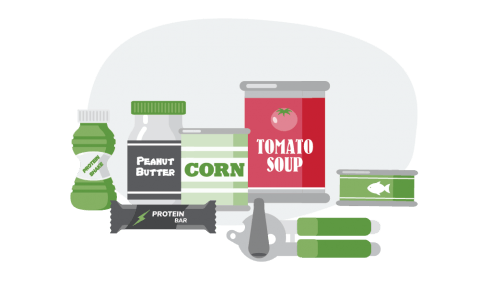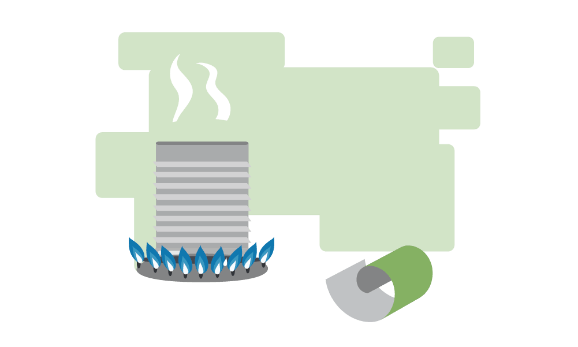Build A Kit and Be Ready Polk!
After an emergency, you may need to survive on your own for several days. Being prepared means having your own food, water and other supplies to last for several days. A disaster supplies kit is a collection of basic items your household may need in the event of an emergency.

Recommended Items to Include in a Basic Emergency Supply Kit:
- Water and non-perishable food for several days.
- Extra cell phone battery or charger.
- Battery-powered or hand crank radio that can receive NOAA Weather Radio tone alerts and extra batteries.
- Flashlight and extra batteries.
- First aid kit.
- Whistle to signal for help.
- Dust mask, to help filter contaminated air and plastic sheeting and duct tape to shelter-in-place.
- Moist towelettes, garbage bags and plastic ties for personal sanitation.
- Non-sparking wrench or pliers to turn off utilities.
- Can opener (if kit contains canned food).
- Local maps.
Additional Items to Consider Adding to an Emergency Supply Kit:
- Prescription medications and glasses.
- Infant formula and diapers.
- Pet food, water and supplies for your pet.
- Important family documents such as copies of insurance policies, identification and bank account records in a portable waterproof container.
- Cash and change.
- Emergency reference material such as a first aid book.
- Sleeping bag or warm blanket for each person. Consider additional bedding for cold-weather.
- Complete change of clothing including a long sleeved shirt, long pants and sturdy shoes.
- Fire Extinguisher.
- Matches in a waterproof container.
- Feminine supplies, personal hygiene items and hand sanitizer.
- Mess kits, Paper cups, plates and disposable utensils, paper towels.
- Paper and pencil.
- Books, games, puzzles or other activities for children.
Maintaining Your Kit
After assembling your kit remember to maintain it so it’s ready when needed:
- Keep canned food in a cool, dry place.
- Store boxed food in tightly closed plastic or metal containers.
- Replace expired items as needed.
- Re-think your needs every year and update your kit as your family’s needs change.
Kit Storage Locations
Since you do not know where you will be when an emergency occurs, prepare supplies for home, work and cars.
Home: Keep this kit in a designated place and have it ready in case you have to leave your home quickly. Make sure all family members know where the kit is kept.
Work: Be prepared to shelter at work for at least 24 hours. Your work kit should include food, water and other necessities like medicines, as well as comfortable walking shoes, stored in a “grab and go” case.
Car: In case you are stranded, keep a kit of emergency supplies in your car.
Suggested Emergency Food Supplies
Consider the following things when putting together your emergency food supplies:
- Store at least a several-day supply of non-perishable food.
- Choose foods your family will eat.
- Remember any special dietary needs.
We suggest the following items when selecting emergency food supplies. You may already have many of these on hand.
- Ready-to-eat canned meats, fruits, vegetables and a can opener
- Protein or fruit bars
- Dry cereal or granola
- Peanut butter
- Dried fruit
- Canned juices
- Non-perishable pasteurized milk
- High-energy foods
- Food for infants
- Comfort/stress foods

Food Safety and Sanitation
Without electricity or a cold source food stored in refrigerators and freezers can become unsafe. Bacteria in food grow rapidly at temperatures between 40 and 140 degrees Fahrenheit and if these foods are consumed you can become very sick. Thawed food usually can be eaten if it is still “refrigerator cold.” It can be re-frozen if it still contains ice crystals. Remember “When in doubt, throw it out.”
Do:
- Keep food in covered containers.
- Keep cooking and eating utensils clean.
- Throw away any food that has come into contact with contaminated flood water.
- Throw away any food that has been at room temperature for two hours or more.
- Throw away any food that has an unusual odor, color or texture.
- Use ready-to-feed formula. If you must mix infant formula use bottled water or boiled water as a last resort.
Don’t:
- Eat foods from cans that are swollen, dented or corroded, even though the product may look safe to eat.
- Eat any food that looks or smells abnormal, even if the can looks normal.
- Let garbage accumulate inside, both for fire and sanitation reasons.
Cooking
Alternative cooking sources can be used in times of emergency including candle warmers, chafing dishes, fondue pots or a fireplace. Charcoal grills and camp stoves are for outdoor use only.
To heat food in a can:

Remove the label.
Thoroughly wash and disinfect the can.
Open the can before heating.
Managing Food without Power
- Keep the refrigerator and freezer doors closed as much as possible.
- The refrigerator will keep food cold for about four hours if it is unopened.
- Refrigerated or frozen foods should be kept at 40 degrees Fahrenheit or below for proper food storage.
- Use a refrigerator thermometer to check temperature.
- Refrigerated food should be safe as long as the power was out for no more than four hours.
- Discard any perishable food such as meat, poultry, fish, eggs or leftovers that have been above 40 degrees Fahrenheit for two hours or more.
Using Dry Ice:
- Know where you can get dry ice prior to a power outage.
- Twenty-five pounds of dry ice will keep a 10 cubic foot freezer below freezing for three to four days.
- If you use dry ice to keep your food cold, make sure it does not come in direct contact with the food.
- Use care when handling dry ice. Wear dry, heavy gloves to avoid injury.
For more information about food safety during an emergency visit FoodSafety.gov.
Remember to follow us on Facebook and Twitter and sign up for free weather alerts via CodeRed
which is a free service for all Polk County Georgia residents!


















